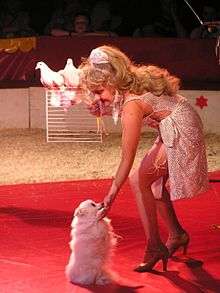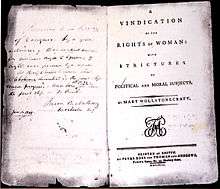Women and animal advocacy

Women have played a central role in animal advocacy since the 19th century. The animal advocacy movement – embracing animal rights, animal welfare, and anti-vivisectionism – has been disproportionately initiated and led by women, particularly in the United Kingdom.[1] Women are more likely to support animal rights than men.[2][3] A 1996 study of adolescents by Linda Pifer suggested that factors that may partially explain this discrepancy include attitudes towards feminism and science, scientific literacy, and the presence of a greater emphasis on "nurturance or compassion" amongst women.[4] Although vegetarianism does not necessarily imply animal advocacy, it is also worth noting that a 1992 market research study conducted by the Yankelovich research organization concluded that "of the 12.4 million people [in the US] who call themselves vegetarian, 68% are female, while only 32% are male".[5]
History

Women and animals were often considered equally irrational and inferior in the past. When the British author Mary Wollstonecraft wrote A Vindication of the Rights of Woman in 1792, British philosopher Thomas Taylor responded anonymously in the same year with A Vindication of the Rights of Brutes, in which he claimed that arguments for the oppression or liberation of women applied equally well to animals, intending it as a reductio ad absurdum of Wollstonecraft's position.[6]
Many of the major British animal advocacy groups founded in the late 1800s and early 1900s, all regarded as radical in their time, were founded by women, including the Battersea Dogs' Home (Mary Tealby, 1860), the National Anti-Vivisection Society (Frances Power Cobbe, from Ireland, 1875), the British Union for the Abolition of Vivisection (Frances Power Cobbe, from Ireland, 1898), and the British Animal Defence and Anti-Vivisection Society (Lizzy Lind af Hageby, from Sweden, and Nina Douglas-Hamilton, Duchess of Hamilton, 1903.)
In 1867 the American philanthropist Caroline Earle White co-founded the Pennsylvania Society for the Prevention of Cruelty to Animals; she also founded its women's branch in 1869, and founded the American Anti-Vivisection Society in 1883.[7]
In 1880, the English feminist Anna Kingsford became one of the first English women to graduate in medicine, after studying for her degree in Paris, and the only student at the time to do so without having experimented on animals. She published The Perfect Way in Diet (1881), advocating vegetarianism, and was also vocal in her opposition to animal experiments.[8]
The British Animal Defence and Anti-Vivisection Society came to widespread attention during the Brown Dog affair (1903–1910), which began when Lizzy Lind af Hageby infiltrated the vivisection in University College London of a brown terrier dog. The subsequent description of the experiment in her book, The Shambles of Science (1903) – in which she wrote that the dog had been conscious throughout and in pain – led to a protracted scandal and a libel case, which the accused researcher won. The affair however continued for several years, making a name both for Lind af Hageby and for the society.[9]
British political scientist Robert Garner writes that 70 percent of the membership of the Victoria Street Society (one of the anti-vivisection groups founded by Frances Power Cobbe) were women, as were 70 percent of the membership of the British Royal Society for the Prevention of Cruelty to Animals in 1900.[10]
Australian writer and academic Coral Lansbury writes that the suffragist movement in the United Kingdom became closely linked with the anti-vivisection movement. Writing about the Brown Dog affair, she argues that the iconography of vivisection struck a chord with women. The vivisected dog muzzled and strapped to the operating board, she argues, was a symbolic reminder of the suffragette on hunger strike restrained and force-fed in Brixton Prison, as well as women strapped into the gynaecologist's chair by their male doctors, for childbirth, for sterilization, as a cure for "hysteria," and as objects of study by male medical students.[11]
Modern women and animal advocacy
In 1944 the Vegan Society, a registered charity and the oldest vegan society in the world, was founded on 1 November in the UK by Elsie "Sally" Shrigley, and 24 others.[12]
The first vegan society in the United States was founded in 1948 by Catherine Nimmo and Rubin Abramowitz in California, who distributed Donald Watson's newsletter.[13]
In 1951 the [American] Animal Welfare Institute was founded by Christine Stevens.
On November 22, 1954, the Humane Society of the United States was founded by Marcia Glaser, Helen Jones, and two men.[14]
In 1962 the Animal Welfare Board of India was founded by Rukmini Devi Arundale.
In 1964 the British author Ruth Harrison published Animal Machines, an influential critique of factory farming, and on October 10, 1965, the British novelist Brigid Brophy had an article, "The Rights of Animals", published in The Sunday Times.[15] Brophy wrote:
The relationship of homo sapiens to the other animals is one of unremitting exploitation. We employ their work; we eat and wear them. We exploit them to serve our superstitions: whereas we used to sacrifice them to our gods and tear out their entrails in order to foresee the future, we now sacrifice them to science, and experiment on their entrail in the hope—or on the mere offchance—that we might thereby see a little more clearly into the present ... To us it seems incredible that the Greek philosophers should have scanned so deeply into right and wrong and yet never noticed the immorality of slavery. Perhaps 3000 years from now it will seem equally incredible that we do not notice the immorality of our own oppression of animals.[15]
British political scientist Robert Garner writes that Ruth Harrison's book and Brigid Brophy's article led to an explosion of interest in the relationship between humans and nonhumans.[16] In particular, Brophy's article was discovered in or around 1969 by a group of postgraduate philosophy students at the University of Oxford, Roslind and Stanley Godlovitch (husband and wife from Canada), John Harris, and David Wood, now known as the Oxford Group. They decided to put together a symposium to discuss the theory of animal rights.[15] Around the same time, the British writer Richard D. Ryder wrote several letters to The Daily Telegraph criticizing animal experimentation; these letters were seen by Brophy, who put Ryder in touch with the Godlovitches and Harris. Harrison, Brophy, and Ryder subsequently became contributors to the Godlovitches' symposium, which was published in 1971 as Animals, Men and Morals: An Inquiry into the Maltreatment of Non-humans (edited by Roslind and Stanley Godlovitch and John Harris).[17]
In 1973 Dr. Shirley McGreal founded the International Primate Protection League in Thailand.[18]
In 1980 the English-born British/American animal rights activist Ingrid Newkirk co-founded People for the Ethical Treatment of Animals, which she is now the president of.
In 1981 Feminists for Animal Rights was founded in California; it became a nationwide organization in the following years and was active nationwide for over two decades, but is now defunct.[19][20]
In 1986, Lorri Houston co-founded Farm Sanctuary, America's first shelter for farm animals.[18]
In 1990 the American author Carol J. Adams published her influential book The Sexual Politics of Meat: A Feminist-Vegetarian Critical Theory, which discusses the connections between feminism and vegetarianism and patriarchy and meat eating, historically and through the reading of literary texts.
Also in 1990, during the March for Animals in Washington, D.C. — the largest animal rights demonstration held until then in the United States — most of the participants were women, but most of the platform speakers were men.[21]
In 1994 Louise Wallis, then President and Chair of the Vegan Society UK, founded World Vegan Day to commemorate the society's 50th anniversary. Vegans around the world now join together to celebrate animal rights every World Vegan Day, held annually on November 1.
In 2006 in the Netherlands, Marianne Thieme and Esther Ouwehand were elected to parliament representing the Party for Animals.
Women have also featured prominently in actions carried out in the name of the Animal Liberation Front and the Hunt Saboteurs Association.
The Unbound Project
In 2015, Jo-Anne McArthur (We Animals) and Keri Cronin (Department of Visual Arts, Brock University), launched The Unbound Project, a multimedia and book project that celebrates the women who have been at the forefront of animal advocacy around the globe.
References
- ↑ Gaarder, Emily. "The 'Gender' Question of Animal Rights: Why are Women the Majority?", paper presented at the annual meeting of the American Sociological Association, Montreal Convention Center, August 11, 2006.
- ↑ Signal, Tania; Taylor, Nicola. (2006). "Attitudes to Animals: Demographics Within a Community Sample". Society & Animals, 14:2, pages 147–157. doi:10.1163/156853006776778743
- ↑ Herzog, Harold. (2007). "Gender Differences in Human-Animal Interactions: A Review". Anthrozoos: A Multidisciplinary Journal of The Interactions of People & Animals. 20:1. Pages 7–21.
- ↑ Pifer, Linda. (1996). "Exploring the Gender Gap in Young Adults' Attitudes about Animal Research". Society and Animals. 4:1. Pages 37–52.
- ↑ "The gender gap: if you're a vegetarian, odds are you're a woman. Why?". Vegetarian Times. February 1, 2005. Retrieved October 27, 2007.
- ↑ Sunstein, Cass R. The Chimps' Day in Court, The New York Times, February 20, 2000.
- ↑ Buettinger, Craig. "Women and antivivisection in late nineteenth century America", Journal of Social History, Vol. 30, No. 4 (Summer, 1997), pp. 857-872.
- ↑ Rudacille, Deborah (2000). The Scalpel and the Butterfly, pp. 31, 46.
- ↑ Kean, Hilda. "The 'Smooth Cool Men of Science': The Feminist and Socialist Response to Vivisection", History Workshop Journal, 1995, 40: 16–38.
- ↑ Garner, Robert. Animals, Politics and Morality. (2005), p. 141.
- ↑ Lansbury, Coral. The Old Brown Dog: Women, Workers, and Vivisection in Edwardian England. The University of Wisconsin Press, 1985, pp. x and 24.
- ↑ "Interview with Donald Watson", Vegetarians in Paradise, August 11, 2004.
- ↑ Stepaniak 2000, pp. 6–7; Linda Austin and Norm Hammond, Oceano, Arcadia Publishing, 2010, p. 39; Freya Dinshah, "Vegan, More than a Dream", American Vegan, Summer 2010, p. 31.
- ↑ "Humane Society of United States founded". Famousdaily.com. Retrieved 2015-07-28.
- 1 2 3 Ryder, Richard (2000) [1989]. Animal Revolution: Changing Attitudes Towards Speciesism, pp. 5–6. Berg.
- ↑ Garner, Robert. Animals, Politics and Morality. (2005), p. 3ff.
- ↑ Godlovitch, Roslind; Godlovitch Stanley; and Harris John (1971). Animals, Men and Morals: An Inquiry into the Maltreatment of Non-humans. Victor Gollancz.
- 1 2 "Hall Of Fame". Arconference.org. Retrieved 2015-05-13.
- ↑ "Feminists for Animal Rights". Farinc.org. Retrieved 2015-05-13.
- ↑ "Feminists for Animal Rights". Farinc.org. Retrieved 2015-05-13.
- ↑ Garner, Robert. Animals, Politics and Morality. (2005), pp. 142–143.
Further reading
- Adams, Carol J. The Sexual Politics of Meat: A Feminist-Vegetarian Critical Theory. (1990)
- Adams, Carol J. and Donovan, Josephine. The Feminist Care Tradition in Animal Ethics: A Reader. (2007)
- Donovan, Josephine. "Animal Rights and Feminist Theory," Signs, Vol. 15, No. 2 (Winter, 1990), pp. 350–375.
- Feminists for Animal Rights
- Kean, Hilda (1995). "The 'Smooth Cool Men of Science': The Feminist and Socialist Response to Vivisection", History Workshop Journal, 40: 16–38.
- Kemmerer, Lisa A. (editor). Sister Species: Women, Animals and Social Justice. (2011)
- Lansbury, Coral. The Old Brown Dog: Women, Workers, and Vivisection in Edwardian England. (1985)
